MSc HCI DesignIndividual Workbook (Creativity in Design)
Don't wanna be here? Send us removal request.
Text
Entry 8: ReCity and Reflection
The final concept design is a reflection of the various design tools explored throughout this blog series. Each discovery and use of methods shaped my thoughts on re-imaging the City of London as I know it. As a group effort, we explored various technological techniques, from Artificial Intelligence to Gaming however what enabled us to consider these techniques as fundamental to our ideas for the Smart City was our capacity to think creatively.
Reflecting on the design discoveries and ideas formed, I can’t help but think about the influence of time. The past, present and future are fluid concepts in respect to design and have influenced and shaped our ideas. Thinking about prehistoric design influences and thinking forward to the infinite possibilities that have still to be discovered, I understand design to be vast and not confined to guidelines. It is fluid and ever present, has many methodologies and tools and has the potential to be reflected in many ways. When considering this in the context of the Smart City, the creativity in the design methods we explored are still open to different interpretations. The one presented in this project by myself and my group was formed based on our individual and collective understanding of what we had discovered through the use of prompts, social experiments and exploratory technological design concepts. I believe our personal experiences with the design we interact with and have discovered so far in our personal lives also influence our interpretations of our findings.
The one thing I struggled with through this project was what is considered an acceptable level of critique on your own understanding of design? And is your own understanding wrong if it doesn’t present you with ideas? Designing for Smart City has been exciting as a group effort and merging ideas has made the concept of ‘what ifs’ some what believable. The final concept reflects this joint creative effort on re-imagining the City perfectly, even if it may not be a possibility just yet.
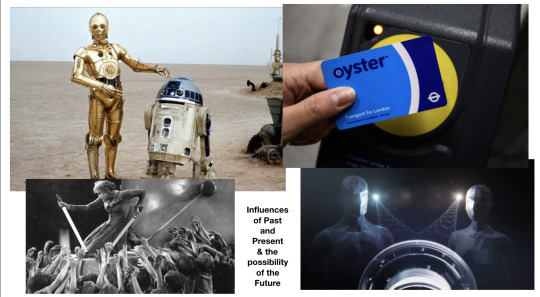
0 notes
Text
Entry 7: Speculative Design
The amalgamation of design thinking, imagination and possibilities within the group resulted in the following components of our final design concept:
1. Holodrons - A device that can be bought at travel points such as stations that are reusable, similar to an Oyster card.
2. Beacons - Placed around the city and when activated, presents a personalised avatar.
3. Holographic Whisper technology - projecting holograms from publicly placed devices that are synced with the beacons. Supported by advancement in 5G technology.
These design concepts are explained in more detail in the final project submission however I wanted to reference them in this post as I feel it is important to note that there is more here than the final product. The publication by Dunne and Raby referenced below, states ’futures are not a destination or something to be strived for but a medium to aid imaginative thought- to speculate with’. I find Speculative Design underpinned this project for me personally at this later stage as it made me think more about the kind of future people want and also the kind people do not want.
One particular point that comes to mind is the individuals that may not want to engage with the proposed Smart City technology. Would this disrupt their environment or cause pressure on these individuals who may feel they need to be involved to stay ‘relevant’. Alternatively, would this type of technology open their imaginations to possible futures in other areas of their lives? The aim of the final concept was to allow people to express themselves, encourage interaction and learn about the city space they flow through daily. The reward being the experience itself. I think our creative output as a group has achieved this on the surface but there are a lot of social contexts to still consider through further research and experiments if this type of technology within a Smart City was to be developed.
(Booked referenced: Dunne, Anthony, and Fiona Raby. Speculative everything: design, fiction, and social dreaming. MIT press, 2013. Library.)
0 notes
Text
Entry 6: Design Development
Developing the design of our Smart City concept was a creatively stimulating process however it was difficult to pin down an idea at the onset of this project. It become clear that designing for the Smart City was never going to be just one idea. Within my group, we have seen a fusion of ideas drawn from many things such as our personal stories, the experiments and observations we conducted as a group, our own interactions within the city our individual and collective understanding of design concepts and methodologies and the exercises we did to expand our ideation sessions. A range of themes emerged such as human, gaming, immersion, guide, VR and AI, etc. Various techniques also emerged such as visual research methods, concept sketching, social experiments and brainstorming. Through this process, ‘visualisation’ had the biggest impact on my creativity. This was not limited to physical visual aids but also visualisation of the project in my mind through ‘imaginative design’ concepts.
However coming back to visible visualisation, I found Gillian Rose’s description of the ‘Future Life’ animations visual content similar to how I have viewed my own creative process from different angles and mediums such as photography, sketching and video to interpret my imagination of the Smart City. While digital art is not my forte I found inspiration fro other works to help me further develop this interpretation through emerging technology such as holograms, artificial intelligence and through spatial experience design (see media below). These concepts were echoed by the rest of the group who also saw exciting technological advances as the key to binding our creative ideas. These ideas helped to expand on the gaming concept of the avatars into something more suitable in a City wide space where other elements of City life could also be considered such as micro-communities of varying interest such as sustainability or cleaning initiatives.
(Link to article - https://visualmethodculture.wordpress.com/2016/06/27/visualising-the-smart-city-as-flow-and-glow/)

0 notes
Text
Entry 5: The Gaming Experience
Drawing from ‘what if’ scenarios expanded our design thinking to consider a combination of different formats for the Smart City such as gaming. The idea of gaming played a significant role overall as the idea of an avatar originated from a game. I find ‘immersion’, ‘engagement’ and ‘involvement’ as discussed in ‘Immersion in Digital Games: a Review of Gaming Experience Research’ to be particularly powerful components to game ideology. Although this was not focused on for our experiment at the National Theatre, I personally found links to these gaming concepts when reviewing material after a research participant was asked to do some creative tasks encouraged by the avatar, such as taking a picture or drawing. The focus was to see how the participant felt about interacting with the avatar. I found her particular description of feeling uncomfortable at first interesting because it made me think back to ‘what if’. After the participant had interacted with the avatar for a while, she reported feeling more comfortable. I thought this could indiciate that the interaction was starting to feel more believable. Although the gaming experience of immersion is much more complex, I could see the possibilities of the varying levels of engagement that may be possible from the proposed concept of the ‘Avatar Guide’.
As a group we found that documenting our process through the use of video helped to reflect on both the Smart City and our own creative process. A video montage showed how our participant moved through the space of the theatre while interacting with the avatar. It also shows our other social experiments merged into one video outlook and made me consider how we might implement this technology in a much bigger space such as the whole City (video can be viewed via link below). New ideas came about such as beacons, wearable technology and kiosks and with this limitations such as disruption to the City space and privacy constraints for using such technology. I found that while we would not be able to cover these constraints in much detail, it also somewhat impacted my thinking for the design possibilities we had creatively put together up to this stage. I was now considering constraints.
(Article discussed: Immersion in Digital Games: a Review of Gaming Experience Research - Paul Cairns, Anna Cox, A. Imran Nordin)
(Video Montage link: https://drive.google.com/drive/u/1/folders/1LqDO4gfVRKV5Amr9AxEjdqyxQ-_ezop_)
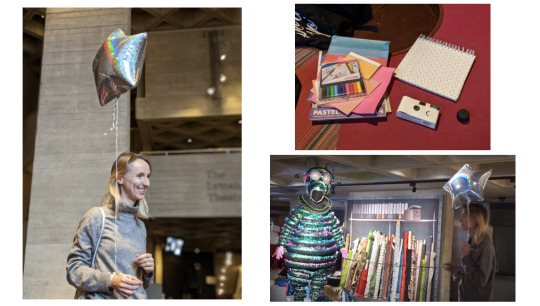
0 notes
Text
Entry 4: Social Experiments
Various social experiments were conducted including a chalk drawing experience and interaction with an ‘avatar’. The social experiments show in the image below was picked based on observations previously conducted in the same space, Neil’s Yard. The ‘Chalk’ experiment was conducted to see if passerby’s would get involved in the experience of drawing on the ground. I though it was particularity interesting to see how creating this new space within a space that already had its own flow from tourists and/or locals was changed to accommodate this new space. People walked around, engaged or stopped out of curiosity, opening up a new possibility for the space. Engaging people with physical prompts (chalk) was particularly powerful as it created a stimulating experience to creatively define a design space, and in my opinion, allowing participants to view the city as a design canvas. The avatar concept was not the focus of this experiment and therefore was just a visual prompt in the form of a balloon.
To further understand this possibility of participation, the second experiment was more successful in creating a narrative where an ‘avatar’ would be used. Here we experimented with an avatar as a guide (a balloon was used again however it was given a ‘voice’ in this instance through the use of a mobile device). The emphasis was on ‘guide’ as we aimed for our smart technology application to be an aid to people rather than a replacement. Specific tasks were created for this experiment to prompt people who participated to engage with other avatars. The goal was to determine if there was a natural behaviour pattern to be seen through these prompts. The use of physical prompts opened up a more creative outlook for eliciting an ‘experience’. It helped to put our design ideas into perspective for the rest of the project.
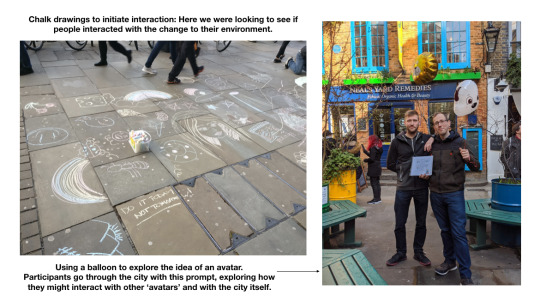
0 notes
Text
Entry 3: What if?
My personal interests for the design of a Smart City lay in immersive technology such as virtual reality. I find VR is revolutionary; a powerful tool in the development of Smart City applications and infrastructure. I believe it can be helpful in various areas such as education, police monitoring and training, disaster response and navigation to name a few.
However, when I think of this very technical application of a design and the idea of ‘design' itself, I have to consider the term Daniela Rosner developed, ‘Critical Fabulations’. Why are those virtual worlds created the way they are? What are the stories behind these worlds? I think this same question applies to the Smart City we have imagined as a group. What world are we trying to make possible? My first post talked about considering the ‘human’ connection in the technologically advanced designs we propose. I think stories, memories, thoughts, hopes and dreams play into this. To tell a story, to share a hope, a view, a dream through an interaction with the city would need to be explored and understood more deeply to be able to design for a Smart City created firstly for people. Rosner’s Core Memory Project provided inspiration for storyboards to help us develop a narrative for our ideas (image of storyboard below - group presentation).
To consider technology such as VR in the context of our group ideas, I also found the ‘what if’ activity particularly creative (see media below). This activity encouraged me to think about weaving stories and consider scenarios regardless of reality and truly expand the imaginative capability of my mind. What made this even more exciting was joining the groups ideas to form a ‘chain’ of our imagination regardless of whether our ideas made sense or if they flowed from one to another. As we discussed each link in the chain, I felt as if we were jumping through the worlds created in our imaginations enhancing what I originally thought might be possible.

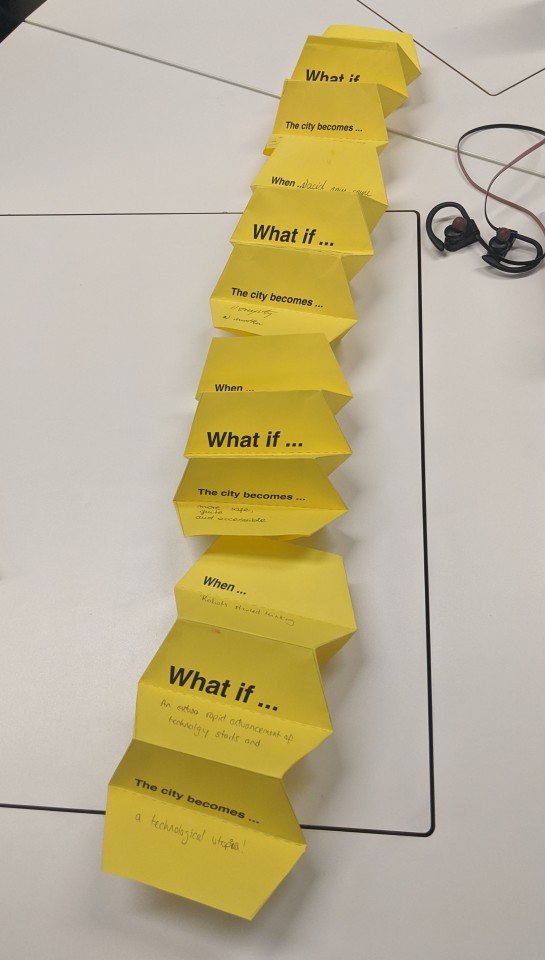
0 notes
Text
Entry 2: Observations and VRM
Many researchers argue that visual materials can ‘reveal what is hidden in the inner mechanisms of the ordinary and the taken for granted’ (Sweetman, 2009). I understand visual research methods as ‘tools’ allowing me to see past the ordinary as we understand it and look deeper towards the ‘what if’. As a group, we took images and videos through several sessions of observations and random walks around the city. The aim was to capture varying angles such as aerial and landscape and also varying light contrast (as seen in collage of pictures below) to help us see the city in a new way - through the lens. I focused on looking beyond the obvious and tried to be perceptive to design in various things such as how people interact with a space, how they flow through a space, the shape of systems, buildings and display of cultural behaviour.
Gillian Rose talks about visual research methods (VRM) needing to expand to keep up with the expanding visual culture we find ourselves in at present. A general observation shows an increase in screens, big and small, an increase in social media posts and an increase in data in the form of media created every day. I do not think this will diminish and therefore know that a visual culture would play a big role in a Smart City. After putting myself in the role of social scientist through the observation sessions, I agree with Rose in that VRM will need to keep pace.
Looking back at our observations, as a group, we discovered we had started paying attention to things we didn’t pay much attention to before. QR codes on statues made us think about augmenting a space with technology that people can interact with. The element of ‘human’ interactions was a core principle to what we wanted from the Smart City. Brainstorming lead to the idea of an avatar which originated from a particular game called Gris. I particularly liked the idea of an avatar guide as a way to visualise technology in a human form, presenting a more natural connection to the City. I though of it as giving the City a visual personality.
(Link to article - Gillian Rose - https://visualmethodculture.wordpress.com/2015/09/25/visual-research-methods-in-an-expanded-field-what-next-for-visual-research-methods/)
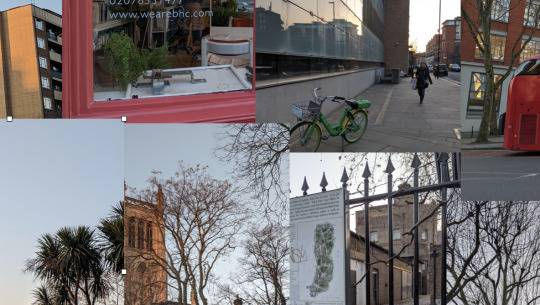

0 notes
Text
Entry 1: Birmingham City centre light and sound display
To kickstart the project, ideation sessions focused on how people move through the City of London. I thought it would be interesting to put into perspective the constraints that already exists which might prevent people from expression or engagement within the spaces they flow through on a daily basis. After discussing expression and engagement based on our personal lives, such as art, dancing, music and designing, an emerging theme of sound and movement materialised. In my personal research within my own home city, I came across a light and sound display in Birmingham which I thought tied into the first group discussion.
The display consisted of 3 posts with speakers which invited passerby’s to talk into it. The output is then converted into a sound and light display based on the frequency of the passerby’s voice. This was reflecting onto a Church behind the display and also into the night sky through a lights display. (see media below). What particularly caught my interest was the behaviour change of the public as a result of this interactive display. One instance being, where someone asked other members of the public to cover the other two posts to get the full effect of the display, therefore changing the usual dynamic within a public space, where if the display was not present this form of interaction among strangers may not have took place.
An example of the use of the smart technology combined with a simple creative expression such as dance can be seen through an interactive installation in Lisbon aimed to encourage pedestrians to wait until it's safe to cross the road by making the traffic lights "dance" using motion capture technology (+ movie). I thought this was particularly effective and interesting in creating a change in the flow of the City to firstly present a safer way for pedestrians to cross the road especially for the impatient and secondly to possibly encourage interaction among people that would not have happened otherwise, similar to the sound and light display discussed above. I have discovered the importance of the ‘human’ side to the Smart City and would like to explore this further through the creative methodologies I will use as this project goes on.
(Link to article: https://www.dezeen.com/2014/09/17/interactive-dancing-traffic-lights-installation-smart-car-lisbon/ ).

0 notes